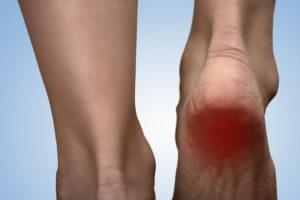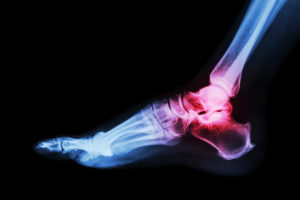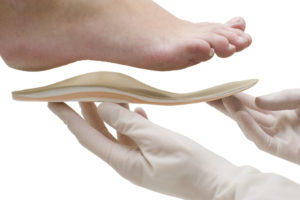Are you in need of plantar fasciitis treatment? Do you have a stubborn and nagging pain at the bottom of your heel, which is at its worst in the mornings? Is the thick tissue at the bottom of your feet slightly swollen and irritable?
If you answer yes to any of the questions above then the likelihood is that you have damaged your plantar fascia and are in need of plantar fasciitis treatment. Believe me; you have my sympathy if you do because as a former sufferer myself, I know only too well how painful and annoying it can be without the right plantar fasciitis treatment.
Austin Plantar Fasciitis Specialists
 An Austin Plantar Fasciitis Doctor will tell you that the two most common forms of a foot injury, which is responsible for that acute pain in your heel, foot, and calf, are Plantar Fasciitis and Heel Spurs. A Plantar Fasciitis Doctor will explain to you that plantar fasciitis refers to the inflammation of a ligament called the plantar fascia. This is the flat tissue that binds the heel of the foot to the ligaments of the toes. Plantar Fasciitis is a painful inflammation of this tissue, which usually occurs at the base of the heel.
An Austin Plantar Fasciitis Doctor will tell you that the two most common forms of a foot injury, which is responsible for that acute pain in your heel, foot, and calf, are Plantar Fasciitis and Heel Spurs. A Plantar Fasciitis Doctor will explain to you that plantar fasciitis refers to the inflammation of a ligament called the plantar fascia. This is the flat tissue that binds the heel of the foot to the ligaments of the toes. Plantar Fasciitis is a painful inflammation of this tissue, which usually occurs at the base of the heel.
Plantar Fasciitis Doctor in Austin: Diagnosis
 A Plantar Fasciitis Doctor diagnoses plantar fasciitis primarily by the occurrence of extreme pain in the heel area of the foot, which is experienced while standing, jogging or running, and improves a little with continued activity and then returns with extensive activity. The pain usually subsides after a period of rest. The Plantar Fasciitis Doctor will tell you that in the initial stages of this problem, the pain subsides with minimal rest and as the problem persists and the tissue degenerates, the pain might take more and more intervals of rest.
A Plantar Fasciitis Doctor diagnoses plantar fasciitis primarily by the occurrence of extreme pain in the heel area of the foot, which is experienced while standing, jogging or running, and improves a little with continued activity and then returns with extensive activity. The pain usually subsides after a period of rest. The Plantar Fasciitis Doctor will tell you that in the initial stages of this problem, the pain subsides with minimal rest and as the problem persists and the tissue degenerates, the pain might take more and more intervals of rest.
Directions to Austin Plantar Fasciitis Doctor
What is Plantar Fasciitis?
 Plantar fasciitis is probably the most common orthopedic condition known to man and mostly affects (although is not limited to) active middle-aged men and women. Statistics suggest that around 10% to 15% of all people could benefit from some sort of plantar fasciitis treatment at least one time in their lives. It can be described in layman’s terms as an aggravating and irritating inflammation of the thick tissue around the heel and sole of the foot.
Plantar fasciitis is probably the most common orthopedic condition known to man and mostly affects (although is not limited to) active middle-aged men and women. Statistics suggest that around 10% to 15% of all people could benefit from some sort of plantar fasciitis treatment at least one time in their lives. It can be described in layman’s terms as an aggravating and irritating inflammation of the thick tissue around the heel and sole of the foot.
It is caused when the plantar fascia is abused and overused. The plantar fascia basically forms the arch of the foot and is a band of tissue connecting the heel to the toes. Not only is the plantar fascia support for the heel, but it is also the main shock-absorber for your feet and of your body. This explains why it is advisable to seek plantar fasciitis treatment.
Common recipients requiring plantar fasciitis treatment are as follows:
- Runners and joggers (especially long distance and cross country runners),
- Overweight and obese people often need plantar fasciitis treatment (especially those who have experienced a sudden weight gain),
- Those with fallen or high foot arches,
- Those whose footwear offers poor support of the arch,
- People whose day-to-day work or activity requires them to spend abnormally long periods on their feet.
However, there is not always an obvious cause for people who need plantar fasciitis treatment (especially for older sufferers) so don’t take the above list as comprehensive.
It is generally most painful in the mornings or after extended periods of inactivity and the pain can be described as a throbbing, sharp type of pain that can cause swelling and tenderness of the heel.
Famous American sports stars who have recently required plantar fasciitis treatment are NY Giants Footballers Aaron Ross & Eli Manning, Chicago Bulls center Joakim Noah and New York Mets pitcher R.A. Dickey.
Austin Heel Pain Doctor: Causes
 The Plantar Fasciitis Doctor informs us that as one grows older the plantar fascia loses its elasticity and the fat pad on the heel is unable to absorb the shock that comes from too much walking or running. This extra shock leads to the excess wear and tear of the plantar fascia resulting in inflammation and pain. Sometimes, this also leads to bruising and swelling.
The Plantar Fasciitis Doctor informs us that as one grows older the plantar fascia loses its elasticity and the fat pad on the heel is unable to absorb the shock that comes from too much walking or running. This extra shock leads to the excess wear and tear of the plantar fascia resulting in inflammation and pain. Sometimes, this also leads to bruising and swelling.
There are certainly other factors that increase the risk of plantar fasciitis and a Plantar Fasciitis Doctor tells his patients to take care of these underlying factors as a precursor to the treatment of Plantar Fasciitis. Some of these factors are as follows:
- Excess body weight.
- High blood sugar levels.
- Excessive standing or walking.
- A sudden increase in activity levels.
- Physiological disorders such as having a flat foot or a high arch.
What Types of Plantar Fasciitis Treatment Are Available in Austin?
Austin is a city famous for its lakes, trails, and general outdoor lifestyle. With so many outdoor free things to do in Austin, it’s no wonder that many suffer from bad shoes and irregular strides. there are numerous different forms of plantar fasciitis treatment which are used and recommended by podiatrists and chiropodists. Some work better than others and recovery times range from a month or so for the lucky ones through to nine to twelve months and longer for others (unfortunately, some people never seem to be able to shake the condition off).
The Plantar Fasciitis Doctor asks the patient what kind of pain he or she is experiencing, the times of the day or night when the pain starts or increases, and since how long the patient has been feeling this pain. Based on the answers of the above-mentioned queries, the Plantar Fasciitis Doctor ascertains whether the patient is suffering from Plantar Fasciitis or some other heel injury.
If the patient tells the Plantar Fasciitis Doctor that the pain first occurs when he or she gets up in the morning and tries to stand, the diagnosis is all probability is Plantar Fasciitis. The Plantar Fasciitis Doctor then further investigates if the pain is like a knife or pin sticking to the heel and gradually subsides as the patient starts his daily chores. This further confirms the occurrence of the Plantar Fasciitis.
Initial Plantar Fasciitis Treatment and Recommendations
 In most cases, the pain associated with the condition will ease over the course of several months. The plantar fascia is very similar to ligament tissue and does not normally recover from damage quickly. There are however some initial plantar fasciitis treatments and recommendations for the condition which may increase the recovery process. They are as follows:
In most cases, the pain associated with the condition will ease over the course of several months. The plantar fascia is very similar to ligament tissue and does not normally recover from damage quickly. There are however some initial plantar fasciitis treatments and recommendations for the condition which may increase the recovery process. They are as follows:
- Rest is often the best form of plantar fasciitis treatment and should be employed as often as possible. Try to stay off of your feet for as long as possible and avoid jogging and running.
- Wear sensible footwear that offers good support to your arch and has cushioned soles. Remember, your plantar fascia is your body’s main shock-absorber and should be treated with care.
- Avoid walking barefoot on hard and uneven surfaces
- Replace your old worn and tatty shoes
- There are different types of pads and insoles available on the market which can ease the pain of the plantar fascia. If you decide to try these out then you must wear them in both shoes at all times – even if the pain is only in one foot.
- There are also custom orthotic shoes available which can help but it’s hard to find any good looking ones.
- There are also other types of shoes such as Fitflops and New Balance which have received favorable feedback from sufferers and they might be worth a try (they look good too!)
- Anti-inflammatory painkillers like Ibuprofen are often recommended as a form of initial plantar fasciitis treatment as they help to reduce the slight swelling often associated with the condition as well as helping with the pain. There are also some anti-inflammatory lotions and creams on the market which can be rubbed on the affected area to help ease the pain.
- Another useful plantar fasciitis treatment is to hold an ice pack on the affected area for about a quarter of an hour
After the primary diagnosis, the plantar fasciitis doctor suggests that the patient reduces his or her daily walking or running and give as much rest as possible to the affected foot. If the patient has been born with certain physiological anomalies such as a flat-foot or a high arch, the Plantar Fasciitis Doctor may then prescribe the use of plantar fasciitis orthotics, which are special shoe inserts.
Other Plantar Fasciitis Treatments and Exercises
There are other specialist plantar fasciitis treatments and exercises available which we will explore in the next article called Plantar Fasciitis Exercises.
Recommended Plantar Fasciitis Treatment Resource
 In my time as a sufferer, I tried most of the initial plantar fasciitis treatments and recommendations listed above, and although they helped to ease the nagging, aggravating pain, the problem was that it kept on coming back when I stopped.
In my time as a sufferer, I tried most of the initial plantar fasciitis treatments and recommendations listed above, and although they helped to ease the nagging, aggravating pain, the problem was that it kept on coming back when I stopped.
After about 12 months of suffering, I found this Plantar Fasciitis Treatment website and my life changed for the better. The information available there helped me to fully recover from the condition within three weeks. Take a look today to discover what I think is the most effective plantar fasciitis treatment available today.